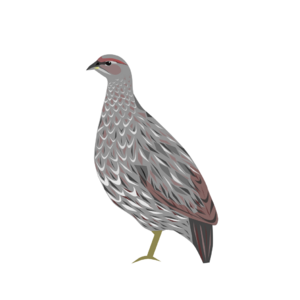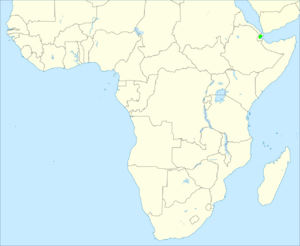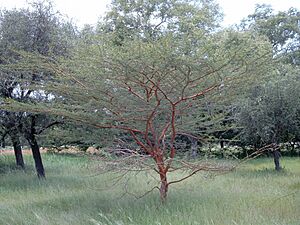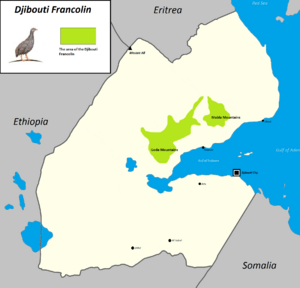Djibouti spurfowl facts for kids
Quick facts for kids Djibouti spurfowl |
|
|---|---|
 |
|
| Conservation status | |
| Scientific classification | |
| Genus: |
Pternistis
|
| Species: |
ochropectus
|
 |
|
| geographic distribution | |
| Synonyms | |
|
|
The Djibouti spurfowl or Djibouti francolin (Pternistis ochropectus) is a special bird that belongs to the pheasant family. It is a critically endangered species, which means it is in great danger of disappearing forever. You can only find this bird in Djibouti, a country in the Horn of Africa.
This spurfowl is mostly grayish-brown. It has white stripes and streaks on its belly, which get finer towards its back. Its head has black markings and a gray top. The bird has a short tail. It is about 35 cm (1.15 ft) long and weighs around 940 g (33 oz).
The Djibouti spurfowl naturally lives in high dry forests. These forests are mostly made of African juniper trees. Sadly, these juniper forests are dying. Because of this, the spurfowl might live in other places, like box-tree forests. This bird is only known from two spots in Djibouti. It lives in small groups and is very shy. It eats berries, seeds, and termites. It lays eggs between December and February.
This bird is critically endangered because its population dropped by 90% in just twenty years. Its juniper home is being damaged by things like too much overgrazing by animals. People are working to help this bird. They are trying to restore the juniper forests and count the birds to learn more about them. They also want to make more people aware of this special bird.
Contents
About the Djibouti Spurfowl
Birds like the Djibouti spurfowl are part of the Phasianidae family. These are ground-dwelling birds found in many parts of the world, often in forests. African spurfowls belong to a group called Pternistis. They live on the ground and eat insects, plants, and seeds. Many male spurfowls have sharp spurs on their legs.
The Djibouti spurfowl was first found on February 22, 1952. French bird experts Jean Dorst and Christian Jouanin described it later that year. They gave it the name Francolinus ochropectus. The name comes from old words meaning "ochre" (a yellowish-brown color) and "breast." Today, it is placed in the Pternistis group.
Some people thought this bird was very similar to other spurfowls. However, it is still considered its own unique species. It doesn't have any different types or subspecies. Local people in Djibouti call this bird the kukaaqe.
What Does It Look Like?
This spurfowl is a large, round bird. It is about 35 cm (1.15 ft) long and weighs around 940 g (33 oz). Its body is grayish-brown. It has white stripes and streaks on its belly that get thinner towards its head. Its back is darker than its belly.
The back of its neck has a reddish-brown tint, and the top of its head is gray. Its forehead, face, and eye area have black markings, like a mask. Its chin and throat are whitish. The bird's eyes are brown. The feathers on its body and neck are gold or straw-colored in the middle, with dark brown borders and white edges. Its tail is short. The beak is black, but the lower part has some yellow. The legs are a greenish-yellow.
Male and female Djibouti spurfowls look quite similar. However, males are usually a bit bigger. Males also have two clear spurs on their legs, while females have almost none. Females also have more reddish-brown color in their tails. Young spurfowls look like adults but are duller. They have buff-colored bars on their bellies instead of streaks.
The call of this bird sounds like a rattling erk erk erk-kkkkkkkk. This sound then turns into a soft, gurgling chuckle. When they are eating, they might make a quiet clucking sound. No other spurfowl in Djibouti looks exactly like this one, so it's easy to tell apart.
Where Does It Live?
The Djibouti spurfowl lives only in Djibouti, a country in eastern Africa. It is found in just two places. One place is the Forêt du Day in the Goda Mountains. This forest is about 25 km (16 mi) north of the Gulf of Tadjoura. This area is only 15 km2 (3,700 acres) big, and its habitat is changing.
The other place is in the Mabla Mountains. These mountains are about 80 km (50 mi) northeast of the Forêt du Day. This area has not been studied much. It has also been more affected by human activity than the Forêt du Day. Because of this, it is thought to be less suitable for the birds. Together, the total area where this bird lives is estimated to be 58 km2 (14,000 acres).
This spurfowl prefers thick African juniper woodlands. These forests have a dense tree cover and are found at heights between 700 and 1,780 m (2,300 and 5,840 ft). You can also find box-trees and African olive trees in these forests. The spurfowl has also been seen in other types of woodlands, like box-tree forests and acacia woodlands. After the breeding season, it might go into more open woodlands and dry riverbeds called wadis.
Much of the African juniper forest where this bird lives has been damaged or destroyed by people. It's not clear if these damaged forests can still support the Djibouti spurfowl. However, some young birds have been seen there. Experts believe the birds are trying to find new homes as close as possible to their damaged juniper forests. Because the juniper trees are declining, box-trees are now the most common trees where the spurfowl lives.
Life and Habits
This bird lives in small groups and is very shy. It often stays hidden in thick plants to avoid being seen. Because of this, we don't know much about its daily life. It is thought that the spurfowl might move from lower areas to higher juniper forests during warmer months. Its main enemy is the common genet, a small cat-like animal.
The bird is most active and likely to call between 6 AM and 9 AM. After this, it might spend most of the day sitting still in a tree, up to 4 m (13 ft) above the ground. It eats berries, seeds, termites, and figs. It scratches the ground to find seeds. When it finds an area where warthogs have dug, it also scratches for termites.
The Djibouti spurfowl is believed to be monogamous, meaning one male and one female stay together. They breed between December and February. Only one nest has ever been found. It was on a mountain ledge and was a shallow dip in the earth lined with grass. These birds sleep in nearby trees, at heights of 5 to 8 m (16 to 26 ft). Local people say that they usually lay 7 to 9 eggs, but this has not been officially confirmed.
Protecting the Djibouti Spurfowl

The IUCN (International Union for Conservation of Nature) says this species is critically endangered. This is because its population dropped by 90% in just twenty years. In 1977, there were about 5600 birds in the Forêt du Day. This was the only known place for them at the time. By 1986, this number had fallen to 1500 birds. The species was found at its second location in the Mabla Mountains in 1986.
While the population in the Mabla Mountains has not been counted yet, the numbers in the Forêt du Day kept dropping. There were only 500 to 1000 Djibouti spurfowls in 1998, and just 115 to 135 in 2004. In 2006, the total number of adult birds in the world was estimated to be between 612 and 723.
This species is in danger because its home is being destroyed. In the Forêt du Day, 95% of its favorite juniper forest is dead or dying. This means it cannot support the birds. We don't know the main reason for this destruction. However, too much grazing by cattle, camels, and goats is thought to be a big cause. Rain, climate change, and a fungal disease also play a part. Hunting, collecting firewood, gathering eggs, and general human activity are also threats. In the Mabla Mountains, the habitat is also being damaged by people collecting firewood and by too much grazing.
In 1937, part of the Forêt du Day was made into a national park. But this protection is no longer active. There have been studies about the area and its environmental problems. However, very few of the ideas from these studies have been put into action. This is partly because of problems in Djibouti since the early 1990s.
In May 2008, an area of 1,000 km2 (250,000 acres) of forest near the village of Day was set aside. This area is used as a tree nursery to help restore some of the spurfowl's damaged home. Experts are also doing surveys to find out how many birds there are and where they live now. They plan to study the unknown site in the Mabla Mountains and other possible areas between the two known sites. In 2008, a campaign was held in local schools to teach children about this special bird.
The Spurfowl and People
Most local people living near where the spurfowl lives think the bird is important. Some value it for its meat, which Muslims in the region might eat. Others see it as a part of their natural heritage. Even though the bird is rarely eaten today because it is so rare, decades ago it was very common. It was easy to catch when it came near villages.
The Djibouti spurfowl has even been shown on two postage stamps. One stamp was from Djibouti in 1989. The other was from the French Territory of the Afars and the Issas in 1972. This was the name for Djibouti when it was under French rule.



